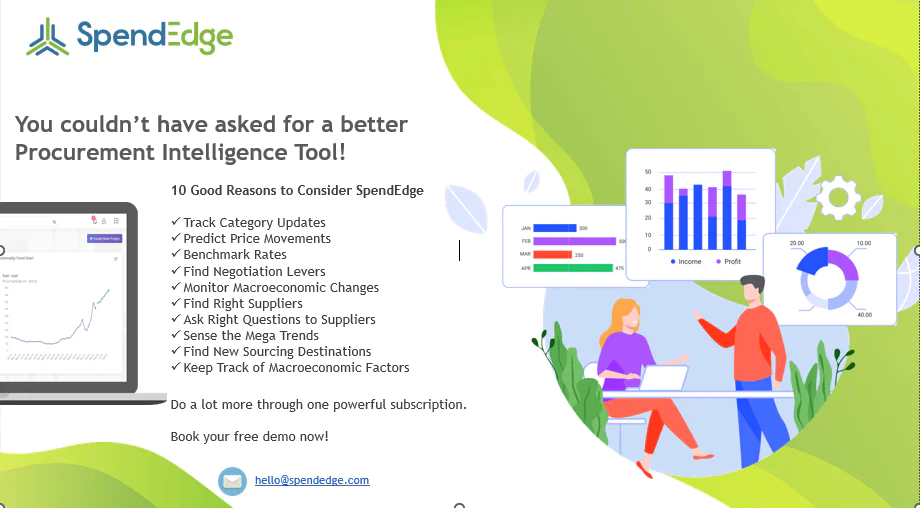Digital transformation has introduced a new era of efficiency and innovation across various sectors, with the banking industry reaping significant benefits. Among these technological advancements, e-procurement stands out as a key element in boosting the operational capabilities of banks. This blog post explores the profound effects of e-procurement on banking operations, detailing its benefits, the challenges it helps overcome, and how solutions from industry leaders like SpendEdge are catalyzing a revolution in this space.
E-procurement, by automating and refining traditional procurement processes, serves as a pivotal tool in the banking sector, enhancing efficiency, reducing costs, and ensuring compliance with stringent industry standards. Through strategic sourcing, e-procurement facilitates better supplier management and optimized procurement strategies that align with the bank’s operational goals and regulatory requirements. This post delves deep into how e-procurement transforms the core operations of banks, backed by real-world applications and expert insights from SpendEdge.
What is E-Procurement?
E-procurement, or electronic procurement, is a technology-driven approach that utilizes digital networks and platforms to facilitate and automate the procurement process within organizations. This modern approach transcends traditional methods by harnessing the power of the internet, specialized software, and cloud-based systems to streamline the entire spectrum of procurement activities. Below, we explore the key components and functionalities of e-procurement systems in detail.
Core Components of E-Procurement
- Electronic Sourcing (e-Sourcing): This involves the use of digital tools to collect and compare supplier information and bids. E-Sourcing enables banks to access a broader market, ensuring a competitive and transparent selection process.
- Electronic Purchasing (e-Purchasing): E-procurement platforms often feature electronic catalogs that list approved products and services, prices, and suppliers. These platforms support purchase order processing, order fulfillment, and transaction management, automating routine purchases and reducing cycle times.
- Contract Management: E-procurement solutions facilitate the digital creation, storage, and management of contracts. This ensures better compliance, quicker access to documents, and more efficient management of contract terms and renewals.
- Supplier Management: Advanced e-procurement systems integrate supplier management tools that help in tracking supplier performance, maintaining supplier information, and managing supplier relationships. This integration improves collaboration and communication with suppliers, enhancing the overall procurement strategy.
The Role of E-Procurement in Banking
In the banking industry, where operational efficiency and regulatory compliance are paramount, e-procurement is proving to be an indispensable tool. By automating and digitizing procurement processes, e-procurement systems facilitate more than just basic transactional activities; they strategically enhance several facets of banking operations. Here’s a detailed exploration of how e-procurement plays a pivotal role in transforming banking operations:
Reducing Costs
Streamlining Procurement Processes: E-procurement systems consolidate various procurement-related tasks into a single integrated platform. This consolidation reduces the need for multiple software solutions and decreases dependency on manual, paper-based processes, which are both time-consuming and error-prone. By automating routine procurement tasks such as requisition, purchase order management, and invoice processing, banks can significantly cut down on administrative overheads and associated transaction costs.
Economies of Scale: With comprehensive access to a wider range of suppliers and global markets, banks can leverage e-procurement tools to negotiate better terms and bulk purchasing discounts. This access helps banks achieve economies of scale, thereby reducing per-unit costs of goods and services procured.
Reduced Cycle Times: The automation of procurement processes shortens the procurement cycle, which in turn reduces holding costs and speeds up the deployment of essential banking supplies and services. Faster cycle times can lead to cost efficiencies across various departments within the bank.
Enhancing Efficiency
Automated Workflows: E-procurement systems automate critical procurement workflows such as approvals, order tracking, and inventory management. This automation reduces the need for human intervention, which not only speeds up operations but also minimizes the risk of errors. Automated alerts and reminders ensure that transactions are processed swiftly, and nothing slips through the cracks.
Real-Time Data Access: E-procurement platforms provide stakeholders with real-time access to procurement data. This capability allows bank managers and procurement teams to make informed decisions quickly, without the delay associated with traditional procurement methods. Real-time data enhances responsiveness to market changes and internal demands, further increasing operational efficiency.
Integration with Other Systems: Most modern e-procurement systems can be integrated with other critical banking systems, such as financial accounting and ERP systems. This integration provides seamless data flow and centralized control, enhancing the overall efficiency of the procurement process and other interconnected business operations.
Improving Compliance and Control
Enhanced Transparency and Auditability: Digital trails created by e-procurement systems offer an auditable record of all transactions, from requisition to payment. This transparency is crucial for internal audits and for complying with external regulations. It ensures that every transaction can be traced to its source, which is critical in meeting stringent compliance standards prevalent in the banking sector.
Regulatory Compliance: The banking industry is heavily regulated, with strict guidelines on procurement ethics and vendor relationships. E-procurement systems help enforce these guidelines by embedding compliance controls into the procurement process. For instance, they can be configured to ensure that all procurements are approved according to the bank’s specific compliance framework and regulatory requirements.
Risk Management: By providing comprehensive oversight of procurement activities, e-procurement systems help identify potential risks related to supplier reliability and product quality. Advanced analytics tools within these systems can predict and mitigate risks by analyzing supplier performance and market trends.
Benefits of E-Procurement in Banking
E-procurement systems provide a multitude of benefits that can significantly transform the banking sector. These benefits not only streamline procurement processes but also enhance overall institutional performance. Here’s a deeper dive into how e-procurement delivers these advantages:
Cost Efficiency
Reduction of Physical Paperwork: One of the primary advantages of e-procurement is the significant reduction in the use of physical paperwork. Transitioning to a digital platform means that many of the documents that were traditionally printed, such as purchase orders and invoices, can now be processed electronically. This transition not only reduces the costs associated with paper, printing, and storage but also speeds up the processing time, reducing the cycle from weeks to possibly a few hours.
Minimization of Manual Handling: E-procurement automates many of the steps that were previously performed manually, from entering data into systems to routing documents for approval. Automation reduces the likelihood of errors and rework, which in turn decreases the need for additional staffing resources devoted to these tasks. This streamlined approach leads to more efficient use of human resources, as staff can redirect their efforts towards more strategic activities rather than administrative tasks.
Optimized Inventory Management: E-procurement enables better management of inventory levels through precise tracking and forecasting tools. This reduces the need for excessive inventory holdings and lowers the costs associated with surplus stock, such as storage and potential obsolescence.
Speed and Productivity
Faster Procurement Cycles: Automation of the procurement process significantly speeds up the entire cycle from requisition to payment. E-procurement systems facilitate quicker approvals through automated routing and electronic notifications, ensuring that purchase orders are processed swiftly. This acceleration helps banks respond more rapidly to department needs, affecting overall operational agility.
Enhanced Staff Productivity: With the repetitive and time-consuming tasks automated, staff can focus on higher-value activities. For example, procurement professionals can spend more time on supplier relationship management, negotiation, and strategic sourcing rather than on paperwork and data entry. This shift not only boosts productivity but also enhances job satisfaction and professional growth.
Transparency and Control
Real-Time Tracking of Transactions: E-procurement systems provide a clear and detailed view of all transactions at every stage of the procurement process. This real-time visibility allows managers and auditors to track expenditures and ensures that procurement activities adhere to predefined budgets and policies.
Improved Expenditure Control: With enhanced tracking capabilities, banks can better manage their expenditures. E-procurement systems offer tools that enforce spending limits, ensure compliance with preferred supplier agreements, and prevent unauthorized purchases. This level of control is crucial for financial planning and maintaining operational budgets.
Increased Compliance: The banking sector is highly regulated, and compliance with these regulations is critical. E-procurement systems support compliance by enforcing corporate and regulatory policies automatically throughout the procurement process. For example, they can restrict procurement options to approved vendors who comply with regulatory standards and can generate reports necessary for regulatory reviews and audits.
Trends and Challenges in Implementing E-Procurement
Despite its benefits, the adoption of e-procurement in banking faces several challenges:
- Technological Integration Barriers: Many banks lack the necessary technological infrastructure, which hampers the seamless integration of e-procurement systems.
- Supplier Enablement: Concerns about data security and the reluctance of suppliers to adopt new methods pose significant hurdles.
- Training and Support: Adequate training and ongoing support are crucial to ensure that all stakeholders can effectively use the new systems.
How SpendEdge Assists in Overcoming These Challenges
SpendEdge, known for its expertise in procurement intelligence and supplier management, addresses e-procurement challenges effectively, as demonstrated by their work with a US-based financial services company facing manual bottlenecks and inefficient expense tracking.
Supplier Management
Identifying and Evaluating Suppliers: SpendEdge uses its vast industry insights to identify and evaluate suppliers that align with the bank’s strategic goals and compliance standards.
Facilitating Better Contract Terms: They negotiate favorable contract terms, focusing on pricing, service quality, and flexibility to adapt to future business environments.
Continuous Supplier Assessment: Ongoing evaluations ensure suppliers meet performance standards, fostering a cooperative relationship adaptable to new challenges.
Category Analysis
Strategic Focus on Key Areas: SpendEdge conducts in-depth analyses to pinpoint high-impact areas in procurement, focusing on cost reduction and risk mitigation.
Tailoring Strategies: Strategies are customized to enhance value, including shifting to cost-effective suppliers or renegotiating contracts.
Best Practices
Benchmarking Against Competitors: SpendEdge benchmarks clients against competitors’ e-procurement practices to glean insights into industry best practices.
Strategic Alignment: They help align e-procurement strategies with industry standards, leveraging advanced technologies like AI and blockchain to optimize operations.
Impact Delivered
The implementation of SpendEdge’s solutions not only streamlined the client’s procurement process but also optimized costs, mitigated risks, and introduced innovative strategies, resulting in significant operational enhancements. These improvements include:
- Cost Optimization: Substantial cost reductions were achieved through strategic supplier partnerships and better procurement practices.
- Enhanced Supplier Performance: Through rigorous supplier evaluations and enhanced collaboration, supplier performance saw marked improvements.
- Operational Efficiency: The reduction of manual processes and the introduction of automated solutions significantly boosted operational efficiency.
Harnessing the Power of E-Procurement in Banking
The integration of e-procurement within the banking sector marks a significant evolution from traditional procurement methods to a streamlined, digitally enhanced approach. This transformation offers substantial improvements in terms of cost efficiency, operational speed, and regulatory compliance. Yet, the shift towards e-procurement is accompanied by complex challenges, including the need for robust technological infrastructure, enhanced security measures, and comprehensive stakeholder training.
Through expert support from industry leaders like SpendEdge, banks are equipped to overcome these hurdles effectively. SpendEdge’s strategic solutions enable banks to refine their procurement processes, from supplier management to contract negotiations, ensuring alignment with both financial goals and compliance standards. The result is not merely an enhancement of current operations but a redefinition of banking procurement strategies, driving sustainable growth and establishing a competitive edge in the rapidly evolving financial landscape.
As banks continue to navigate this complex landscape, the strategic implementation of e-procurement stands out as a critical component. By embracing these technological advances, banks can transform their procurement activities, unlocking new levels of efficiency and strategic capability, ultimately leading to greater resilience and success in the global market.
To learn more about how SpendEdge can revolutionize your banking operations through e-procurement, visit SpendEdge.





